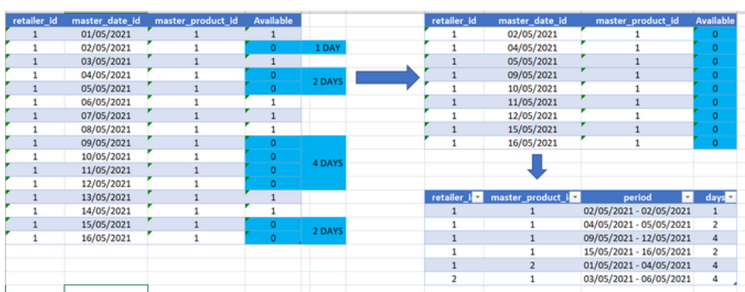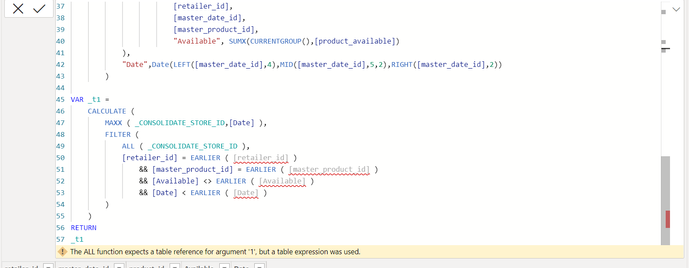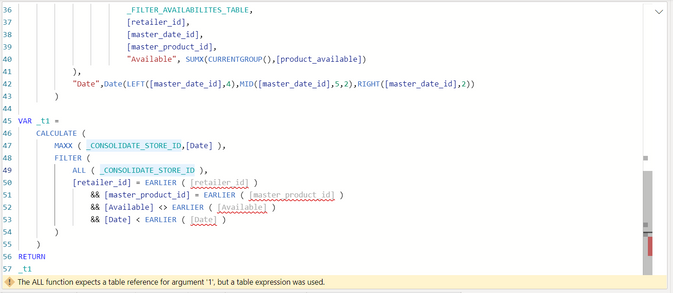- Power BI forums
- Updates
- News & Announcements
- Get Help with Power BI
- Desktop
- Service
- Report Server
- Power Query
- Mobile Apps
- Developer
- DAX Commands and Tips
- Custom Visuals Development Discussion
- Health and Life Sciences
- Power BI Spanish forums
- Translated Spanish Desktop
- Power Platform Integration - Better Together!
- Power Platform Integrations (Read-only)
- Power Platform and Dynamics 365 Integrations (Read-only)
- Training and Consulting
- Instructor Led Training
- Dashboard in a Day for Women, by Women
- Galleries
- Community Connections & How-To Videos
- COVID-19 Data Stories Gallery
- Themes Gallery
- Data Stories Gallery
- R Script Showcase
- Webinars and Video Gallery
- Quick Measures Gallery
- 2021 MSBizAppsSummit Gallery
- 2020 MSBizAppsSummit Gallery
- 2019 MSBizAppsSummit Gallery
- Events
- Ideas
- Custom Visuals Ideas
- Issues
- Issues
- Events
- Upcoming Events
- Community Blog
- Power BI Community Blog
- Custom Visuals Community Blog
- Community Support
- Community Accounts & Registration
- Using the Community
- Community Feedback
Register now to learn Fabric in free live sessions led by the best Microsoft experts. From Apr 16 to May 9, in English and Spanish.
- Power BI forums
- Forums
- Get Help with Power BI
- Desktop
- Re: Calculate number of consecutive days in stocko...
- Subscribe to RSS Feed
- Mark Topic as New
- Mark Topic as Read
- Float this Topic for Current User
- Bookmark
- Subscribe
- Printer Friendly Page
- Mark as New
- Bookmark
- Subscribe
- Mute
- Subscribe to RSS Feed
- Permalink
- Report Inappropriate Content
Calculate number of consecutive days in stockout
Hello, good afternoon,
I have a calculated table with which I get in a column named available if a product was available in a store on a certain date as shown in the following image.
What I intend to obtain are the consecutive days in which the available column was zero, since with this I obtain the number of consecutive days that a product was out of stock in a certain store, I have already tried it in several ways but I cannot find how to achieve this , I hope you can help me
Solved! Go to Solution.
- Mark as New
- Bookmark
- Subscribe
- Mute
- Subscribe to RSS Feed
- Permalink
- Report Inappropriate Content
Hi @Yeztrom ,
According to your description, I download your pbix file. As your data is too large, I think create a new calculated table is not a good solution, it will lead the report to run too slow.
Here's my solution.
Create two columns.
Period =
VAR _Start =
MAXX (
FILTER (
'vw_product_availabilies',
'vw_product_availabilies'[master_date_id]
< EARLIER ( 'vw_product_availabilies'[master_date_id] )
&& 'vw_product_availabilies'[product_available] = 1
&& 'vw_product_availabilies'[retailer_id]
= EARLIER ( vw_product_availabilies[retailer_id] )
&& 'vw_product_availabilies'[master_product_id]
= EARLIER ( vw_product_availabilies[master_product_id] )
),
'vw_product_availabilies'[master_date_id]
)
VAR _End =
MINX (
FILTER (
'vw_product_availabilies',
'vw_product_availabilies'[master_date_id]
> EARLIER ( 'vw_product_availabilies'[master_date_id] )
&& 'vw_product_availabilies'[product_available] = 1
&& 'vw_product_availabilies'[retailer_id]
= EARLIER ( vw_product_availabilies[retailer_id] )
&& 'vw_product_availabilies'[master_product_id]
= EARLIER ( vw_product_availabilies[master_product_id] )
),
'vw_product_availabilies'[master_date_id]
)
VAR _Start2 =
IF (
_Start = BLANK (),
MIN ( 'vw_product_availabilies'[master_date_id] ),
MINX (
FILTER (
'vw_product_availabilies',
'vw_product_availabilies'[retailer_id]
= EARLIER ( vw_product_availabilies[retailer_id] )
&& 'vw_product_availabilies'[master_product_id]
= EARLIER ( vw_product_availabilies[master_product_id] )
&& 'vw_product_availabilies'[master_date_id] > _Start
),
'vw_product_availabilies'[master_date_id]
)
)
VAR _End2 =
IF (
_End = BLANK (),
MAX ( 'vw_product_availabilies'[master_date_id] ),
MAXX (
FILTER (
'vw_product_availabilies',
'vw_product_availabilies'[retailer_id]
= EARLIER ( vw_product_availabilies[retailer_id] )
&& 'vw_product_availabilies'[master_product_id]
= EARLIER ( vw_product_availabilies[master_product_id] )
&& 'vw_product_availabilies'[master_date_id] < _End
),
'vw_product_availabilies'[master_date_id]
)
)
RETURN
IF (
'vw_product_availabilies'[product_available] = 1,
BLANK (),
_Start2 & "-" & _End2
)
days = IF('vw_product_availabilies'[Period]=BLANK(),BLANK(),1)
The days column will add up in the visual.
I attach my sample below for reference.
Best Regards,
Community Support Team _ kalyj
If this post helps, then please consider Accept it as the solution to help the other members find it more quickly.
- Mark as New
- Bookmark
- Subscribe
- Mute
- Subscribe to RSS Feed
- Permalink
- Report Inappropriate Content
Hi @Yeztrom ,
According to your description, I download your pbix file. As your data is too large, I think create a new calculated table is not a good solution, it will lead the report to run too slow.
Here's my solution.
Create two columns.
Period =
VAR _Start =
MAXX (
FILTER (
'vw_product_availabilies',
'vw_product_availabilies'[master_date_id]
< EARLIER ( 'vw_product_availabilies'[master_date_id] )
&& 'vw_product_availabilies'[product_available] = 1
&& 'vw_product_availabilies'[retailer_id]
= EARLIER ( vw_product_availabilies[retailer_id] )
&& 'vw_product_availabilies'[master_product_id]
= EARLIER ( vw_product_availabilies[master_product_id] )
),
'vw_product_availabilies'[master_date_id]
)
VAR _End =
MINX (
FILTER (
'vw_product_availabilies',
'vw_product_availabilies'[master_date_id]
> EARLIER ( 'vw_product_availabilies'[master_date_id] )
&& 'vw_product_availabilies'[product_available] = 1
&& 'vw_product_availabilies'[retailer_id]
= EARLIER ( vw_product_availabilies[retailer_id] )
&& 'vw_product_availabilies'[master_product_id]
= EARLIER ( vw_product_availabilies[master_product_id] )
),
'vw_product_availabilies'[master_date_id]
)
VAR _Start2 =
IF (
_Start = BLANK (),
MIN ( 'vw_product_availabilies'[master_date_id] ),
MINX (
FILTER (
'vw_product_availabilies',
'vw_product_availabilies'[retailer_id]
= EARLIER ( vw_product_availabilies[retailer_id] )
&& 'vw_product_availabilies'[master_product_id]
= EARLIER ( vw_product_availabilies[master_product_id] )
&& 'vw_product_availabilies'[master_date_id] > _Start
),
'vw_product_availabilies'[master_date_id]
)
)
VAR _End2 =
IF (
_End = BLANK (),
MAX ( 'vw_product_availabilies'[master_date_id] ),
MAXX (
FILTER (
'vw_product_availabilies',
'vw_product_availabilies'[retailer_id]
= EARLIER ( vw_product_availabilies[retailer_id] )
&& 'vw_product_availabilies'[master_product_id]
= EARLIER ( vw_product_availabilies[master_product_id] )
&& 'vw_product_availabilies'[master_date_id] < _End
),
'vw_product_availabilies'[master_date_id]
)
)
RETURN
IF (
'vw_product_availabilies'[product_available] = 1,
BLANK (),
_Start2 & "-" & _End2
)
days = IF('vw_product_availabilies'[Period]=BLANK(),BLANK(),1)
The days column will add up in the visual.
I attach my sample below for reference.
Best Regards,
Community Support Team _ kalyj
If this post helps, then please consider Accept it as the solution to help the other members find it more quickly.
- Mark as New
- Bookmark
- Subscribe
- Mute
- Subscribe to RSS Feed
- Permalink
- Report Inappropriate Content
Hi,
there might be a better way to do this, but here is one option:
first create this calculated column, which identifies the first day in a group of consecutive days:
FirstDateOfGroup =
VAR _t1 =
CALCULATE (
MAX ( stock[Date] ),
FILTER (
ALL ( stock ),
stock[retailer_id] = EARLIER ( stock[retailer_id] )
&& stock[product_id] = EARLIER ( stock[product_id] )
&& stock[Available] <> EARLIER ( stock[Available] )
&& stock[Date] < EARLIER ( stock[Date] )
)
)
VAR _t2 =
CALCULATE (
MIN ( stock[Date] ),
FILTER (
ALL ( stock ),
stock[retailer_id] = EARLIER ( stock[retailer_id] )
&& stock[product_id] = EARLIER ( stock[product_id] )
&& stock[Available]
== EARLIER ( stock[Available] )
&& stock[Date] <= EARLIER ( stock[Date] )
)
)
RETURN
IF ( ISBLANK ( _t1 ), _t2, _t1 + 1 )
then this calculated column to count the number of days within each group:
NumberOfConsecutiveDaysOutOfStock =
IF (
stock[Available] = 0,
COUNTROWS (
FILTER (
ALL ( stock ),
stock[retailer_id] = EARLIER ( stock[retailer_id] )
&& stock[product_id] = EARLIER ( stock[product_id] )
&& stock[Available]
== EARLIER ( stock[Available] )
&& stock[FirstDateOfGroup] = EARLIER ( stock[FirstDateOfGroup] )
)
),
BLANK ()
)
the rest of your requirements should be fairly easy to obtain based on these two columns.
Cheers,
Sturla
If this post helps, then please consider Accepting it as the solution. Kudos are nice too.
- Mark as New
- Bookmark
- Subscribe
- Mute
- Subscribe to RSS Feed
- Permalink
- Report Inappropriate Content
Hello good afternoon, thanks for the support,
I have one more doubt, is it possible to put all the calculations in a single measure?
All this calculation is going to be used inside a measure that is going to be shown in the dashboard, it is going to show in the return the functions max, min and several things apart, the reason why it is done this way is because the measure has to be dynamic and the result shown has to vary depending on the selected filters.
I tried to put all the calculations into one measurement but I got this error
The measure is:
- Mark as New
- Bookmark
- Subscribe
- Mute
- Subscribe to RSS Feed
- Permalink
- Report Inappropriate Content
Hello good afternoon, thank you for your support,
I have one more doubt, is it possible to put all the calculations in a single measure?
All this calculation is going to be used inside a measure that is going to be shown in the dashboard, it is going to be shown in the return the functions max, min, etc, the reason why it is done this way is because the measure has to be dynamic and the result shown has to vary depending on the selected filters.
I tried to put the measures into one but I got this error
This is the complete measure I am trying to use
The file used is:
https://drive.google.com/file/d/13VxrfEpRmxTaZy-GiVOhwcJD2_2Qqxq7/view?usp=sharing
Helpful resources

Microsoft Fabric Learn Together
Covering the world! 9:00-10:30 AM Sydney, 4:00-5:30 PM CET (Paris/Berlin), 7:00-8:30 PM Mexico City

Power BI Monthly Update - April 2024
Check out the April 2024 Power BI update to learn about new features.

| User | Count |
|---|---|
| 110 | |
| 94 | |
| 80 | |
| 67 | |
| 59 |
| User | Count |
|---|---|
| 150 | |
| 119 | |
| 104 | |
| 87 | |
| 67 |




